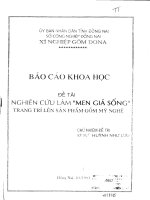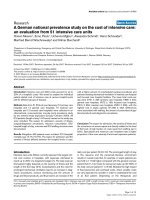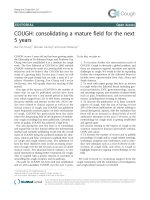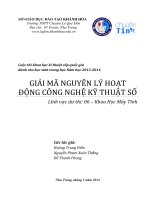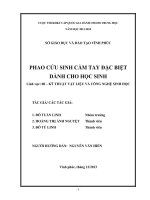Báo cáo khoa học: "úp cho các bạn có thêm kiến thức về ngành y học đề tài: Statistics review 10: Further nonparametric methods" docx
Bạn đang xem bản rút gọn của tài liệu. Xem và tải ngay bản đầy đủ của tài liệu tại đây (57.43 KB, 4 trang )
196
ICU = intensive care unit.
Critical Care June 2004 Vol 8 No 3 Bewick et al.
Introduction
The previous review in this series [1] described analysis of
variance, the method used to test for differences between
more than two groups or treatments. However, in order to use
analysis of variance, the observations are assumed to have
been selected from Normally distributed populations with
equal variance. The tests described in this review require only
limited assumptions about the data.
The Kruskal–Wallis test is the nonparametric alternative to
one-way analysis of variance, which is used to test for
differences between more than two populations when the
samples are independent. The Jonckheere–Terpstra test is a
variation that can be used when the treatments are ordered.
When the samples are related, the Friedman test can be used.
Kruskal–Wallis test
The Kruskal–Wallis test is an extension of the Mann–Whitney
test [2] for more than two independent samples. It is the
nonparametric alternative to one-way analysis of variance.
Instead of comparing population means, this method
compares population mean ranks (i.e. medians). For this test
the null hypothesis is that the population medians are equal,
versus the alternative that there is a difference between at
least two of them.
The test statistic for one-way analysis of variance is
calculated as the ratio of the treatment sum of squares to the
residual sum of squares [1]. The Kruskal–Wallis test uses the
same method but, as with many nonparametric tests, the
ranks of the data are used in place of the raw data.
This results in the following test statistic:
Where R
j
is the total of the ranks for the jth sample, n
j
is the
sample size for the jth sample, k is the number of samples,
and N is the total sample size, given by:
This is approximately distributed as a χ
2
distribution with k – 1
degrees of freedom. Where there are ties within the data set
the adjusted test statistic is calculated as:
Where r
ij
is the rank for the ith observation in the jth sample,
n
j
is the number of observations in the jth sample, and S
2
is
given by the following:
Review
Statistics review 10: Further nonparametric methods
Viv Bewick
1
, Liz Cheek
2
and Jonathan Ball
3
1
Senior Lecturer, School of Computing, Mathematical and Information Sciences, University of Brighton, Brighton, UK
2
Senior Lecturer, School of Computing, Mathematical and Information Sciences, University of Brighton, Brighton, UK
3
Senior Registrar in ICU, Liverpool Hospital, Sydney, Australia
Corresponding author: Viv Bewick,
Published online: 16 April 2004 Critical Care 2004, 8:196-199 (DOI 10.1186/cc2857)
This article is online at />© 2004 BioMed Central Ltd
Abstract
This review introduces nonparametric methods for testing differences between more than two groups
or treatments. Three of the more common tests are described in detail, together with multiple
comparison procedures for identifying specific differences between pairs of groups.
Keywords Friedman test, Jonckheere–Terpstra test, Kruskal–Wallis test, least significant difference
)1(3
)1(
12
1
2
+−
+
=
∑
=
N
n
R
NN
T
k
j
j
j
∑
=
k
j
j
n
1
.
+
−=
∑
=
4
)1(1
2
1
2
2
NN
n
R
S
T
k
j
j
j
197
Available online />For example, consider the length of stay following admission
to three intensive care units (ICUs): cardiothoracic, medical
and neurosurgical. The data in Table 1 show the length of
stay of a random sample of patients from each of the three
ICUs. As with the Mann–Whitney test, the data must be
ranked as though they come from a single sample, ignoring
the ward. Where two values are tied (i.e. identical), each is
given the mean of their ranks. For example, the two 7s each
receive a rank of (5 + 6)/2 = 5.5, and the three 11s a rank of
(9 +10 + 11)/3 = 10. The ranks are shown in brackets in
Table 2.
For the data in Table 1, the sums of ranks for each ward are
29.5, 48.5 and 75, respectively, and the total sum of the squares
of the individual ranks is 5.5
2
+ 1
2
+ … + 10
2
= 1782.5. The
test statistic is calculated as follows:
This gives a P value of 0.032 when compared with a χ
2
distribution with 2 degrees of freedom. This indicates a
significant difference in length of stay between at least two of
the wards. The test statistic adjusted for ties is calculated as
follows:
This gives a P value of 0.031. As can be seen, there is very
little difference between the unadjusted and the adjusted test
statistics because the number of ties is relatively small. This
test is found in most statistical packages and the output from
one is given in Table 3.
Multiple comparisons
If the null hypothesis of no difference between treatments is
rejected, then it is possible to identify which pairs of
treatments differ by calculating a least significant difference.
Treatments i and j are significantly different at the 5%
significance level if the difference between their mean ranks
is greater than the least significant difference (i.e. if the
following inequality is true):
Where t is the value from the t distribution for a 5%
significance level and N – k degrees of freedom.
For the data given in Table 1, the least significant difference
when comparing the cardiothoracic with medical ICU, or
medical with neurosurgical ICU, and the difference between
the mean ranks for the cardiothoracic and medical ICUs are
as follows:
The difference between the mean ranks for the cardiothoracic
and medical ICUs is 4.8, which is less than 5.26, suggesting
that the average length of stay in these ICUs does not differ.
The same conclusion can be reached when comparing the
+
−
−
=
∑∑
==
k
j
n
i
ij
j
NN
r
N
S
11
2
22
4
)1(
1
1
Table 1
Length of stay (days) following admission
Cardiothoracic ICU Medical ICU Neurosurgical ICU
7420
1725
21613
6119
11 21 14
811
ICU, intensive care unit.
Table 2
The data and their ranks
Cardiothoracic ICU Medical ICU Neurosurgical ICU
7 (5.5) 4 (3) 20 (15)
1 (1) 7 (5.5) 25 (17)
2 (2) 16 (14) 13 (12)
6 (4) 11 (10) 9 (8)
11 (10) 21 (16) 14 (13)
8 (7) 11 (10)
ICU, intensive care unit.
Table 3
The Kruskal–Wallis test on the data from Table 1: stay versus
type
Type n Median Average rank
166.54.9
2 5 11.0 9.7
3 6 13.5 12.5
Overall 17 9.0
T = 6.90 DF = 2 P = 0.032
T = 6.94 DF = 2 P = 0.031 (adjusted for ties)
DF, degrees of freedom.
()
90.61173
6
75
5
5.48
6
5.29
)117(17
12
T
222
=+−
++
+
=
94.6
4
)117(17
5.1782
117
1
4
)117(17
6
75
5
5.48
6
5.29
T
2
2
222
=
+
−
−
+
−
++
=
n
1
n
1
kN
T1N
S
n
R
n
R
ji
2
j
j
i
i
+
−
−−
×>−
t
8.4
5
5.48
6
5.29
and 5.26
5
1
6
1
317
6.94117
34.25145.2 =−=
+
−
−−
×
198
Critical Care June 2004 Vol 8 No 3 Bewick et al.
medical with neurosurgical ICU, where the difference
between mean ranks is 4.9. However, the difference
between the mean ranks for the cardiothoracic and
neurosurgical ICUs is 7.6, with a least significant difference
of 5.0 (calculated using the formula above with n
i
= n
j
= 6),
indicating a significant difference between length of stays on
these ICUs.
The Jonckheere–Terpstra test
There are situations in which treatments are ordered in some
way, for example the increasing dosages of a drug. In these
cases a test with the more specific alternative hypothesis that
the population medians are ordered in a particular direction
may be required. For example, the alternative hypothesis
could be as follows: population median
1
≤ population
median
2
≤ population median
3
. This is a one-tail test, and
reversing the inequalities gives an analagous test in the
opposite tail. Here, the Jonckheere–Terpstra test can be
used, with test statistic T
JT
calculated as:
Where U
xy
is the number of observations in group y that are
greater than each observation in group x. This is compared
with a standard Normal distribution.
This test will be illustrated using the data in Table 1 with the
alternative hypothesis that time spent by patients in the three
ICUs increases in the order cardiothoracic (ICU 1), medical
(ICU 2) and neurosurgical (ICU 3).
U
12
compares the observations in ICU 1 with ICU 2. It is
calculated as follows. The first value in sample 1 is 7; in
sample 2 there are three higher values and a tied value, giving
7 the score of 3.5. The second value in sample 1 is 1; in
sample 2 there are 5 higher values giving 1 the score of 5.
U
12
is given by the total scores for each value in sample 1:
3.5 + 5 + 5 + 4 + 2.5 + 3 = 23. In the same way U
13
is
calculated as 6 + 6 + 6 + 6 + 4.5 + 6 = 34.5 and U
23
as 6 +
6 + 2 + 4.5 + 1 = 19.5. Comparisons are made between all
combinations of ordered pairs of groups. For the data in
Table 1 the test statistic is calculated as follows:
Comparing this with a standard Normal distribution gives a P
value of 0.005, indicating that the increase in length of stay
with ICU is significant, in the order cardiothoracic, medical
and neurosurgical.
The Friedman Test
The Friedman test is an extension of the sign test for matched
pairs [2] and is used when the data arise from more than two
related samples. For example, the data in Table 4 are the pain
scores measured on a visual–analogue scale between 0 and
100 of five patients with chronic pain who were given four
treatments in a random order (with washout periods). The
scores for each patient are ranked. Table 5 contains the
ranks for Table 4. The ranks replace the observations, and the
total of the ranks for each patient is the same, automatically
removing differences between patients.
In general, the patients form the blocks in the experiment,
producing related observations. Denoting the number of
treatments by k, the number of patients (blocks) by b, and the
sum of the ranks for each treatment by R
1
, R
2
… R
k
, the usual
form of the Friedman statistic is as follows:
Under the null hypothesis of no differences between
treatments, the test statistic approximately follows a χ
2
distribution with k – 1 degrees of freedom. For the data in
Table 4:
72
)3n2(n)3N2(N
4
nN
U
k
1j
j
2
j
2
k
1j
2
j
2
xy
∑
∑
∑
=
=
+−+
−
−
55.2
72
))312(6)310(5)312(6()334(17
4
)656(17
77
2222
2222
=
+++++−+
++−
−
Table 4
Pain scores of five patients each receiving four separate
treatments
Treatment
Patient A B C D
16 91016
2 9 16 16 32
3141422 67
4101440 19
5111617 60
Table 5
Ranks for the data in Table 4
Treatment
Patient A B C D
11 2 3 4
2 1 2.5 2.5 4
3 1.5 1.5 3 4
41 2 4 3
51 2 3 4
Sum (R
j
) 5.5 10 15.5 19
1)3b(kRj
1)bk(k
12
T
k
1j
2
+−
+
=
∑
=
199
b = 5, k = 4 and = 731.5
This gives the following:
= 12.78
with 3 degrees of freedom
Comparing this result with tables, or using a computer
package, gives a P value of 0.005, indicating there is a
significant difference between treatments.
An adjustment for ties is often made to the calculation. The
adjustment employs a correction factor C = (bk[k + 1]
2
)/4.
Denoting the rank of each individual observation by r
ij
, the
adjusted test statistic is:
T
1
=
For the data in Table 4:
= 12 + 22 + … + 32 + 42 = 149 and C = = 125
Therefore, T
1
= 3 × [731.5 – 5 × 125]/(149 – 125) = 13.31,
giving a smaller P value of 0.004.
Multiple comparisons
If the null hypothesis of no difference between treatments is
rejected, then it is again possible to identify which pairs of
treatments differ by calculating a least significant difference.
Treatments i and j are significantly different at the 5%
significance level if the difference between the sum of their
ranks is more than the least significant difference (i.e. the
following inequality is true):
Where t is the value from the t distribution for a 5%
significance level and (b – 1)(k – 1) degrees of freedom.
For the data given in Table 4, the degrees of freedom for the
least significant difference are 4 × 3 = 12 and the least
significant difference is:
= 4.9
The difference between the sum of the ranks for treatments B
and C is 5.5, which is greater than 4.9, indicating that these
two treatments are significantly different. However, the
difference in the sum of ranks between treatments A and B is
4.5, and between C and D it is 3.5, and so these pairs of
treatments have not been shown to differ.
Limitations
The advantages and disadvantages of nonparametric
methods were discussed in Statistics review 6 [2]. Although
the range of nonparametric tests is increasing, they are not all
found in standard statistical packages. However, the tests
described in the present review are commonly available.
When the assumptions for analysis of variance are not
tenable, the corresponding nonparametric tests, as well as
being appropriate, can be more powerful.
Conclusion
The Kruskal–Wallis, Jonckheere–Terpstra and Friedman tests
can be used to test for differences between more than two
groups or treatments when the assumptions for analysis of
variance are not held.
Further details on the methods discussed in this review, and
on other nonparametric methods, can be found, for example,
in Sprent and Smeeton [3] or Conover [4].
Competing interests
None declared.
References
1. Bewick V, Cheek L, Ball J: Statistics review 9: Analysis of vari-
ance. Crit Care 2004, 7:451-459.
2. Whitely E, Ball J: Statistics review 6: Nonparametric methods.
Crit Care 2002, 6:509-513.
3. Sprent P, Smeeton NC: Applied Nonparametric Statistical
Methods, 3rd edn. London, UK: Chapman & Hall/CRC; 2001.
4. Conover WJ: Practical Nonparametric Statistics, 3rd edn. New
York, USA: John Wiley & Sons; 1999.
Available online />∑
=
+++=
k
1j
)
2
19
2
5.51
2
10
2
(5.5
2
j
R
1)(4535.731
1)(445
12
T +××−×
+××
=
−
−−
∑∑∑
===
CrbCR1)(k
k
1j
b
1i
2
ij
k
1i
2
i
∑∑
==
k
1j
b
1i
2
ij
r
4
2
1)(445
+××
1)1)(k(bR-rb2 RjR
k
1i
2
i
k
1j
b
1i
2
iji
−−
×>−
∑∑∑
===
t
()
3)4(31.5749152179.2
×−×××
